Fallschirmjäger (disambiguation)
| Fallschirmjäger | |
|---|---|
 Fallschirmschützenabzeichen | |
| Active | 1935-1945 |
| Country | |
| Branch | Luftwaffe |
| Type | Paratrooper Infantry |
| Part of | Luftwaffe |
| Garrison/HQ | Berlin |
| Engagements | World War II |
(often rendered Fallschirmjager in English; from the German Fallschirm "parachute" and Jäger, the light elite infantry of the Prussian army) are German paratroopers. Fallschirmjäger of Germany in World War II were the first to be committed in large-scale airborne operations. They came to be known as the "Green Devils" by the Allied forces they fought against.[1] During the entirety of World War II, the Fallschirmjäger commander was Kurt Student.
History

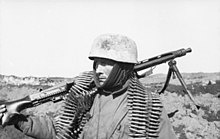

1920s
During the interwar years the rapid development of aircraft and aviation technology drew the attention of imaginative military planners. The idea of inserting a large body of troops inside enemy territory was first proposed during World War I by commander of the U.S. Air Corps in France—Brigadier General Billy Mitchell.[2] However the Allied High Command was forced to abandon the idea as it was wholly unprepared for such an undertaking, both logistically and in materiel.[2] Among the first to recognize the potential of airborne forces were Italy and the Soviet Union.[3] The first effective means of supporting massed infantry airborne operations came with the development of the static-line parachute in Italy in the 1920s, whereby parachutes are attached to the inside of the aircraft and deployed automatically upon departure.[3] This technique allowed the jumps to occur at lower altitudes, limiting exposure to enemy fire, and providing a tighter drop zone grouping than individually deployed rip-cord type parachutes.[3]
1930s
The Soviets were the first to demonstrate the military possibilities of airborne infantry in the 1930s with a series of maneuvers held in 1935 and 1936.[3] Though somewhat crude (the Soviet paratroopers had to exit their slow-moving Tupolev TB-3 transporters through a hatch in the roof and then position themselves along the wings and jump together), the exercise managed to land 1,000 troops through air-drops followed by another 2,500 soldiers with heavy equipment delivered via airlandings. The gathered forces proceeded to carry out conventional infantry attacks with the support of heavy machine guns and light artillery.[4] Among the foreign observers present was Hermann Göring.[4]
Impressed, the ambitious Göring became personally committed to the creation of Germany's airborne arm in the 1930s[5]. As the Prussian Prime Minister of the Interior, he ordered the formation of a specialist police unit in 1933, the Polizeiabteilung z.b.V. Wecke, devoted to protecting Nazi party officials. The organization of this unit was entrusted to Polizeimajor Walther Wecke of the Prussian Police Force, who had assembled a special detachment of 14 officers and 400 men within just two days.[5] On 17 July, the detachment was officially renamed Landespolizeigruppe Wecke z.b.V., and was the first Landespolizeigruppe in Germany.[6] On 22 December 1933, the unit was again retitled, becoming the Landespolizeigruppe General Göring. The unit carried out conventional police duties for the next two years under the command of Göring's ministerial adjutant Friedrich Jakoby[6], but it was Göring's intention to ultimately produce a unit that would match the Reichswehr.
In March-April 1935, Göring transformed the Landespolizei General Göring into Germany's first dedicated airborne regiment, giving it the military designation Regiment General Göring (RGG) on 1 April 1935 (after Hitler introduced conscription on 16 March 1935).[6] The unit was incorporated into the newly-formed Luftwaffe' on October 1 of the same year and training commenced at Altengrabow. Göring also ordered that a group of volunteers be drawn for parachute training. These volunteers would form a core Fallschirmschützen Bataillon ("parachute soldiers battalion"), a cadre for future Fallschirmtruppe ("parachute troops").[6] In January 1936, 600 men and officers formed the 1st Jäger Battalion/RGG, commanded by Bruno Bräuer, and the 15th Engineer Company/RGG and were transferred to training area Döberitz for jump training while the rest of the regiment was sent to Altengrabow.[7] Germany's parachute arm was officially inaugurated on 29 January 1936[8] with an Order of the Day calling for recruits for parachute training at the Stendal Parachute Training School located 96 km (60 mi) west of Berlin. The school was activated several months after the first parachute units were established in January 1936 and was open to active and reserve Luftwaffe personnel. NCOs, officers and other ranks of the Luftwaffe were required to successfully complete six jumps in order to receive the Luftwaffe Parachutist's Badge (instituted on 5 November 1936).[8]
World War II
During World War II, the German Air Force (Luftwaffe) raised a variety of airborne light infantry (Fallschirmjäger) units. Unlike the United Kingdom, the British Commonwealth, and the USA, the German paratroopers were part of the Luftwaffe rather than the Heer (German Army). Starting from a small collection of Fallschirmjäger battalions at the beginning of the war, the Luftwaffe built up a division-sized unit of three Fallschirmjäger regiments plus supporting arms and air assets, known as the 7th Flieger Division (7th Air Division).
Fallschirmjäger units made the first airborne invasion when invading Denmark on the 9 April 1940. In the early morning hours of Operation Weserübung, they attacked and took control of Aalborg Air Base which played a key role acting as a refuel station for the Luftwaffe in the subsequent invasion of Norway. In the same assault the bridges around Aalborg were taken. Other airborne attacks during the Battle of Denmark were also carried out, including one on a fort on the island Masnedø.
The first opposed airborne attacks occurred during the Norwegian Campaign, first during the initial invasion when Fallschirmjägers captured the defended air base of Sola, near Stavanger. The Fallschirmjäger also had their first defeat in Norway, when a company was dropped on the village and railroad junction of Dombås on 14 April 1940 and was destroyed by the Norwegian Army in a five day battle.[9]
Later in the war, the 7th Air Division's Fallschirmjäger assets were re-organised and used as the core of a new series of elite Luftwaffe Infantry divisions, numbered in a series beginning with the 1st Fallschirmjäger Division. These formations were organized and equipped as motorized infantry divisions, and often played a "fire brigade" role on the western front. Their constituents were often encountered on the battlefield as ad hoc battle groups (Kampfgruppen) detached from a division or organized from miscellaneous available assets. In accord with standard German practice, these were called by their commander's name, such as Group Erdmann in France and the Ramcke Parachute Brigade in North Africa.
After mid-1944, Fallschirmjäger were no longer trained as paratroops due to the realities of the strategic situation, but retained the Fallschirmjäger honorific. Near the end of the war, the series of new Fallschirmjäger divisions extended to more than 12, with a concomitant reduction in quality in the higher-numbered units of the series. Among these divisions was the 9th Fallschirmjäger Division, which was the final parachute division to be raised by Germany during World War II. The division was destroyed during the Battle of Berlin in April 1945. (These divisions should not be confused with the Luftwaffe Field Divisions, a poorly organised and managed series of light infantry divisions raised from excess Luftwaffe personnel early in the war.)
Over 54,449 paratroops were killed in action and over 8,000 are still listed as missing in action. [citation needed]
Fallschirmjäger were awarded a total of 134 Knight's Cross of the Iron Crosses between the years 1940–1945. Twenty-four KC were awarded in the west and 27 were awarded after Crete. Out of the 134 KC, 15 were with oak leaves, five with oak leaves and swords, and one with oak leaves, swords and diamonds.
Operations
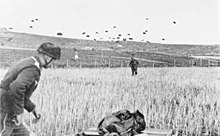

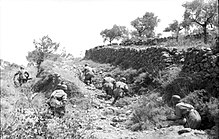
Fallschirmjäger participated in many of the famous battles of World War II and in many theatres. As elite troops they were frequently deployed at the vanguard of attacks and as the bulwark of a defence. They would see action in the Norway and Denmark campaign and in Belgium, Holland and France in 1940. Major actions in the Balkans Campaign, Crete, Italy, and on both the Eastern Front and later the Western Front would follow.
Selection of notable battles
The skilful airborne seizure of Fort Eben-Emael allowed for the early capture of Belgium and, alongside successful operations in Holland, was crucial for the speed of the German victories in 1940. The major successful airdrops in Norway and Denmark in May 1940 was also vital to the success of the campaign there.
The Battle of Crete in 1941 saw large scale airdrops, where the entire 7th Air Division was deployed with the German 5th Mountain Division as the follow-up. Crete was captured, along with many enemy troops and weapons, but the high casualties suffered by the Fallschirmjäger as they parachuted in convinced Hitler that such mass airdrops were no longer feasible (though unknown to the Germans surprise had been lost before the drops started due to Enigma machine cipher cracking).
Fallschirmjäger also played a key role defending positions in France against much larger forces during the Battle of Normandy in 1944. The Battle of Carentan, as depicted in Band of Brothers saw Fallschirmjäger fight with American paratroopers in a short but intense engagement, and also in the Brothers in Arms game series.
The Battle of Monte Cassino was one of the finest displays of the courage, tenacity and skill that the Fallschirmjäger became known for. The 1st Fallschirmjäger Division held the ground near the Monastery of Monte Cassino but did not occupy the building itself. The historical significance of the Benedictine monastery caused the German commander-in-chief in Italy, Field Marshal Albert Kesselring, to order German units not to include the monastery in German defensive positions and informed the Allies accordingly[10][11]. The Allied high command refused to believe that the German forces would not use such a valuable position in their defences and orders were duly given for the 1500 year old building to be bombed to rubble. After the bombing, the Germans moved into positions amongst the bricks, remnants of walls and still intact cellars which provided excellent protection for the troops. This enabled the Fallschirmjäger to hold out for months against repeated assaults and heavy bombardment. Here, they gained the nickname of the "Green Devils" from the Allied forces for their distinctive ¾-length splinter pattern camouflage jackets and the tenacious defence of the ruined town and monastery on the mountain above against far superior numbers. Inflicting huge losses on the allied forces, they only finally retreated from their positions to stave off being outflanked. After their withdrawal, Polish, Gurkha, Senegalese, Moroccan and Brazilian forces finally occupied the ruins of the monastery.
Also in Italy, a smaller but equally fierce battle occurred as the 3rd battalion, 3rd Regt, 1st Fallschirmjäger Division fought against elements of the 1st Canadian Infantry Division and the 1st Canadian Armoured Brigade during the Battle of Ortona, Italy, from December 20, 1943 to December 28, 1943. The battle was dubbed "Little Stalingrad"[12] for the deadliness of its close-quarters combat.
Uniforms and Equipment
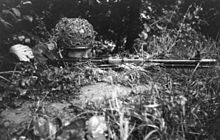

Fallschirmjäger would be awarded the Fallschirmschützenabzeichen, a paratrooper insignia featuring a diving gold eagle gripping a swastika.
A special version of the German armed forces' (Wehrmacht's) modernized steel helmet (Stahlhelm), the M1935, called the Fallschirmhelm, was designed and issued to Fallschirmjäger units. It did away with the projecting visor and deep, flared rim of the standard-issue helmet, and added further improvements. The modified shell incorporated a completely different and more substantial leather liner and chinstrap design that provided far more protection for German airborne troops; this model was known as the "M1938".
The style of parachute harness used by the Fallschirmjäger, however, is generally considered inferior to those used by the war's British and American paratroopers. Unlike the British and American models, which connected the chute at each shoulder, the German design connected the parachute to the trooper's body via a single strap in the center of the back, an Irving-type harness. Paratroopers had to throw themselves bodily forwards out of the aeroplane, and in the resulting face-down position when the chute opened, control was nearly impossible. The necessity of landing on knees and elbows reduced the amount of equipment the trooper could carry and, even with pads, significantly increased the chance of injury. As such they jumped armed only with a holstered pistol and a small "gravity knife". Rifles and other weapons were dropped in separate containers and, until these were recovered, the soldiers were relatively poorly armed (by comparison, Allied paratroopers were dropped armed with rifles or submachine guns). The Japanese copied the German system.
Fallschirmjäger units were usually very well equipped; they had access to the best weapons of the German military. They were among the first combat units to use assault rifles and recoilless weapons in combat. Fallschirmjäger also readily employed the best of several foreign-made small arms, including the Italian Beretta Modello 38 9 mm submachine gun,[13] and the FN Browning P-35 9 mm pistol.
A universal weapon was developed specifically for the paratroopers that could replace rifles, submachine guns and light machine guns but was also light enough to be carried during a jump. These efforts resulted in the FG 42 automatic rifle which combined the firepower of a machine gun with the lightweight handling characteristics of a standard infantry rifle. The FG 42 was built and deployed in small numbers from 1943 until the end of the war. Though an extremely advanced weapon[14][15], the design had some drawbacks. The lightweight frame was subject to considerable muzzle rise when in automatic fire and had to be fired prone to guarantee accuracy. This meant that the FG 42 was not entirely compatible with the more universal role it was supposed to play, as both a light machine gun and assault rifle. The FG 42's advanced design also meant that the weapon could not be mass-produced in a cost efficient manner, and use of certain precious metals in the gun's construction placed it in competition with other wartime projects for increasingly scarce resources.
The Parachutist's "Ten Commandments"
A revealing document captured from a German paratrooper who was taken prisoner in Greece reveals much of the Fallschirmjägers elite attitude. Titled the Ten Commandments[16] it listed the following instructions:
- You are the elite of the German Army. For you, combat shall be fulfillment. You shall seek it out and train yourself to stand any test.
- Cultivate true comradeship, for together with your comrades you will triumph or die.
- Be shy of speech and incorruptible. Men act, women chatter; chatter will bring you to the grave.
- Calm and caution, vigor and determination, valour and a fanatical offensive spirit will make you superior in attack.
- In facing the foe, ammunition is the most precious thing. He who shoots uselessly, merely to reassure himself, is a man without guts. He is a weakling and does not deserve the title of paratrooper.
- Never surrender. Your honour lies in Victory or Death.
- Only with good weapons can you have success. So look after them on the principle—First my weapons, then myself.
- You must grasp the full meaning of an operation so that, should your leader fall by the way, you can carry it out with coolness and caution.
- Fight chivalrously against an honest foe; armed irregulars deserve no quarter.
- Keep your eyes wide open. Tune yourself to the top most pitch. Be nimble as a greyhound, as tough as leather, as hard as Krupp steel and so you shall be the German warrior incarnate.
Luftwaffe parachute units
Larger units
- Fallschirmjägerarmee
- Fallschirmjägerkorps
Fallschirmjägerdivisionen
- 1. Fallschirmjägerdivision, Fallschirmjägerregimenter (FJR).1, FJR.3, FJR.4 , 1st FJAR
- (as 7th Flieger Division with FJR.1, FJR.2, FJR.3, FJR.4, FJR.5)
- 2. Fallschirmjägerdivision, FJR.2, FJR.6, FJR.7, FJR.23, 2nd FJAR
- 3. Fallschirmjägerdivision, FJR.5, FJR.8, FJR.9
- 4. Fallschirmjägerdivision, (formed from the Italian 184th Nembo Parachute Division (Italy); destroyed at Anzio.[17]) FJR.10, FJR.11, FJR.12
- 5. Fallschirmjägerdivision, (the last parachute trained unit) FJR.13, FJR.14, FJR.15, 5th FJAR
- 6. Fallschirmjägerdivision, FJR.16, FJR.17, FJR.18
- 7. Fallschirmjägerdivision, (only some of its units were parachute trained) FJR.19, FJR.20, FJR.21
- (as Fallschirm-Jäger-Division Erdmann: FJR.Menzel, Grossmehl, Greve, Hübner, Laytved-Hardegg)
- 8. Fallschirmjägerdivision, FJR.22, FJR.24, FJR.32
- 9. Fallschirmjägerdivision, FJR.25, FJR.26, FJR.27
- 10. Fallschirmjägerdivision, FJR.28, FJR.29, FJR.30, 10th FJAR
- 11. Fallschirmjägerdivision, FJR.37, FJR.38, FJR.39, 11th FJAR
- 20. Fallschirmjägerdivision, (never finished forming) FJR.58, FJR.59, FJR.60, 20th FJAR
- 21. Fallschirmjägerdivision, (never finished forming) FJR.61, FJR.62, FJR.63 formed from Sturm-Brigade Gericke and Fallschirmjäger-Ausbildungs-und-Ersatz-Division
- Fallschirmjäger-Ausbildungs-und-Ersatz-Division, formed basis for 20. Fallschirmjägerdivision and 21. Fallschirmjägerdivision
Regiments and Brigades
- Brigades
- Ramcke Parachute Brigade aka Luftwaffen-Jäger-Brigade 1
- Luftlande-Sturm-Regiment with Battalions I, II, III, and IV.
- Barenthin Regiment- formed from drafts from other units
- Fallschirmjäger-Sturmgeschütz-Brigaden - Assault gun Units equipped with StuG III's and StuG IV's
- Fallschirmjäger-Sturmgeschütz-Brigade XI - StuG III's only
- Fallschirmjäger-Sturmgeschütz-Brigade XII
- Regiments
- Heerestruppe (Army Troops) FJR.6, FJR.31, FJR. z.b.V., FJR. Schellmann, FJR. Jungwirth
- Fallschirmjäger-Regiment Hübner aka Fallschirmjäger Regiment (FJR) 24 and subordinated to the 8. Fallschirmjäger Division.
Other parachute units
- Waffen SS
- Heer
- Schweres-Fallschirm-Infanterie Battalion
- Brandenburger Regiment aka Panzergrenadier-Division Brandenburg
- German 22nd Air Landing Division
- German 91st Air Landing Division
- Luftwaffe
- Para-trained commandos of II/KG200 (also known as the 3rd Staffel of Kampfgeschwader 200), were a Luftwaffe special forces unit who were para-trained commandos. II./KG 200 remain a mostly unheard of arm of Germany's WW2 parachute forces due to the nature of their role and were listed on II./KG 200's ORBAT as the 3rd Staffel.
After 1945/Bundeswehr Fallschirmjäger
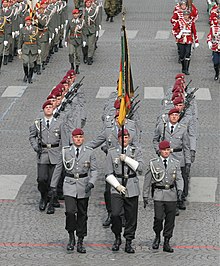
In the modern German Bundeswehr, Fallschirmjäger continue to form the core of Special Operations. The Division has two brigade equivalents and several independent companies and battalions. All in all in 2010 about 10,000 troops will serve in that division, most of them being support or logistics personnel. The Division will have the following structure:
- Special Operations Division
- Headquarters Company (stationed in Stadtallendorf)
- Airborne Signal Battalion (Stadtallendorf)
- Airborne Air Defence Missile Battery 100 (Seedorf)
- Long Range Reconnaissance Training Company 200 (Pfullendorf)
- Army Band 300 (Koblenz)
- Airborne Brigade 26 (Saarlouis)
- Headquarters Company (Saarlouis)
- Airborne Reconnaissance Company 260 (Zweibrücken)
- Airborne Engineer Company 260 (Saarlouis)
- Fallschirmjäger Battalion 261 (Lebach)
- Airborne Support Battalion 262 (Merzig)
- Fallschirmjäger Battalion 263 (Zweibrücken)
- Airborne Brigade 31 (Oldenburg)
- Headquarters Company (Oldenburg)
- Airborne Reconnaissance Company 310 (Seedorf)
- Airborne Engineer Company 270 (Seedorf)
- Fallschirmjäger Battalion 313 (Seedorf)
- Fallschirmjäger Battalion 373 (Seedorf)
- Airborne Support Battalion 272 (Oldenburg, Seedorf)
- Special Forces Command (KSK) (Calw)
The vast majority of division members is deployable by parachute, while all of it is at least air mobile. Almost all vehicles and heavy equipment is transportable by helicopter, including special lightly armored Wiesel fighting vehicles taken into service for this purpose. In addition to the Special Operations Division Germany is also setting up an air mobile or air assault unit of (German) regiment size.
National People's Army
- 40. Fallschirmjägerbataillon Willi Sänger was the only airborne infantry formation of the Nationale Volksarmee (NVA). The battalion and its airborne-commando school were based in Prora at the Rügen island (1961–82) and near Potsdam (1982–90). Officially, the battalion was an airborne unit organized as an NVA light infantry battalion, but in reality it was more considered a special force commando unit like US Army Special Forces. On mission, the companies of the battalion were to be split up in to five-six man teams to increase it's shadowbility. As a force with special capability it remained under the direct command of the Kommando Landstreitkräfte (KdoLaSK) — the army high command.
- The reconnaissance company of the Felix Dzerzhinsky Watch Regiment (German: Wachregiment "Feliks E. Dzierzynski"), an elite motorized rifles regiment of the Ministry for State Security of the German Democratic Republic (GDR), was a paratroop trained unit.
In popular culture
In the Jack Higgins book and movie adaption The Eagle Has Landed, a group of Fallschirmjäger are featured in a fictional covert operation where they secretly land on the English coast in an attempt to kidnap Winston Churchill. Within the book and movie, the Fallschirmjäger are among the few German characters in fiction to be portrayed as professional soldiers and even heroic as one sacrifices his life to save a British girl who fell into the spillway of the Studley Constable village grist mill, and the commanding officer, portrayed by Michael Caine, throws his career away in an attempt to save a Jewish girl from SS and Polizei troops overseeing a transport to one of the Todeslager in the East, commanded by SS-Gruppenfuhrer Jurgen Stroop.
In the video game Turning Point: Fall of Liberty, the main attack force in the initial Nazi invasion of New York city, are Fallschirmjäger troops. They are first seen when they land on the skyscraper the player character is working on.
In the massively multiplayer online game World War II Online, it is possible for Axis players to play as Fallschirmjäger. Parachute drops are possible.
In the WW2 real-time strategy game Company of Heroes, Fallschirmjäger are portrayed as stealthy units, able to hide in cover and infiltrate the battlefield unseen, and as extremely lethal to enemy infantry when equipped with their FG42. They are not seen actually fulfilling their namesake as paratroopers (despite requiring the Luftwaffe Support Tree), but instead summoned from any building around the battlefield, having infiltrated it beforehand.
In the popular first-person shooter Medal of Honor Airborne, the Fallschirmjäger appear as more difficult enemies in later missions, armed with sniper rifles and powerful automatic weapons.
In the first-person shooter Brothers in Arms: Hell's Highway multiplayer, the player can play as a member of a squad of Fallschirmjäger on the German side, opposite of an American Airborne squad.
See also
- Bruno Bräuer
- Eugen Meindl
- Hermann-Bernhard Ramcke
- Kurt Student
- Otto Skorzeny
- Max Schmeling
- Bert Trautmann
- Battle of Crete
- Battle of Monte Cassino
- Fallschirmjäger memorial
- Airborne forces, Luftwaffe, Wehrmacht
References
- ^ Green Devils: German Paratroopers 1939-1945 By Jean-Yves Nasse, W. Muhlberger, G. Schubert, Jean-Pierre Villaume,
- ^ a b Ailsby, Christopher: Hitler's Sky Warriors: German Paratroopers in Action, 1939-1945, page 12. Spellmount Limited, 2000.
- ^ a b c d Ailsby, 16
- ^ a b Ailsby, 18
- ^ a b Ailsby, 21
- ^ a b c d Ailsby, 22
- ^ Ailsby, 23
- ^ a b Ailsby, 26
- ^ Bjørn Jervaas: The Fallschirmjäger Battle at Dombaas Template:En icon
- ^ Time, The Bombing of Monte Cassino
- ^ [Monte Cassinoby David Hapgood (Author), David Richardson]
- ^ Ortona By Mark Zuehlke # Publisher: Douglas & McIntyre (May 2004)Language EnglishISBN 1550545574 ISBN 978-1550545579
- ^ Quarrie, Bruce, Fallschirmjäger: German Paratrooper, 1935-45, Osprey Publishing (2001), ISBN 1841763268, 9781841763262, p. 59
- ^ Senich, Peter: The German Assault Rifle: 1935–1945, page 239. Paladin Press, 1987.
- ^ Miller, David: Fighting Men of World War II: Axis Forces : Uniforms, Equipment and Weapons, page 104. Stackpole Books, 2007.
- ^ U.S. World War II intelligence report on Fallschirmjäger
- ^ Battaglione Paracadutisti Nembo
Bibliography
- Ailsby, Christopher (2000). Hitler's Sky Warriors: German Paratroopers in Action, 1939-1945. Staplehurst, UK: Spellmount Limited. ISBN 1-86227-109-7.
{{cite book}}: Cite has empty unknown parameter:|coauthors=(help)
External links
- 5thfjr.com 5th FJR - WWII Reenactment Unit
- U.S. World War II intelligence report on Fallschirmjäger
- Weapons and equipment of the Fallschirmjäger
- hist2004 Fallschirmjäger on the Eastern Front 1941-1945 24 May 2004
- GermanParatrooper.org FJR 5 - WWII Reenactment Unit.
- The Frontline Association WW2 re-enactment group, mainly portraying Fallschirmjäger Regiment 9
- WW2 uniform of the fallschirmjäger
- Fallschirmjäger 1 Parachute Division Information on 1st Fallschirmjäger Division
- Green Devils of Carentan FJR 6 - WW2 Fallschirmjäger Reenactment
